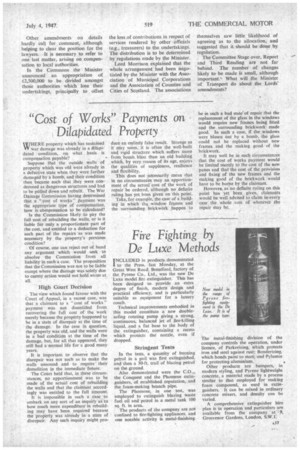"Cost of Works" Payments on Dilapidated Property WHERE property which
Page 47

If you've noticed an error in this article please click here to report it so we can fix it.
has sustained VV war damage was already in a dilapidated condition, on what . basis is
compensation payable?
Suppose that the outside walls of property which was old were already in a defective state when they were further damaged by a bomb, and their condition then became such that they were condemned as dangerous structures and had to be pulled down and rebuilt. The War Damage Commission having determined that a "cost of works" payment was the appropriate type of compensation, how is compensation to be calculated?
Is the Commission likely to pay the fail cost of rebuilding the walls, or is it liable for only a proportionate part of the cost, and entitled to a deduction for such part of the repairs -as was made necessary by the property's previous condition?
Of course, one can reject out of hand any argument which would seek to absolve the Commission from all liability in such a case. The proposition that the Commission was not to be liable except where the damage was solely due to enemy action would not hold water at all.
High Court Decision The view which found favour with the Court of Appeal, in a recent case, was that a claimant to a "cost of works" payment was not disentitled from recovering the full cost of the work merely because the property happened to be in a 'state of disrepair at the time of the damage. In the case in question, the property was old, and the walls were in a bad condition at the time of the damage, but, for all that appeared, they still had a normal life for a good many years.
It is important to observe that the disrepair was not such as to make the walls unsound and to require their demolition in the immediate future.
The Court held that, in these circumstances, no apportionment was to be made of the actual cost of rebuilding the walls and that the claimant accordingly was entitled to the full amount.
It is impossible in such a ease to embark on any sort of an inquiry as to how much more expenditure in rebuilding may have been required because the Property was already in a state of disrepair. Any such inquiry might pro
duce an entirely false result. Strange as it May seem, it is often the well-built and rigid structure which suffers more from bomb, blast than an old building which, by very reason of its age, enjoys the qualities of suppleness, resilience and flexibility.
This does not necessarily mean that in no circumstances may an apportionment of the actual cost of the Work of repair be ordered, although no definite ruling has yet, been given on this point.
Take, for example, the case of a build-, ing in which the .window frames and the surrounding brickwork happen to be in such a bad state' of repair that the replacement of the glass in the windows would require new frames being fitted and the surrounding brickwork made good. In such a case, if the windows were blown out by a bomb, the glass could not be replaced without new frames and the making good of the brickwork.
It may well be in such circumstances that the cost of works payment would be limited merely to the cost of the new panes and that the cost of the provision and fixing of the new frames and the making good of the brickwork would have to be borne by the claimant.
Howeves, as no definite ruling on this point has yet been given, claimants would be well advised to claim in every case the whole cost of whatever the • repair may be.












































































